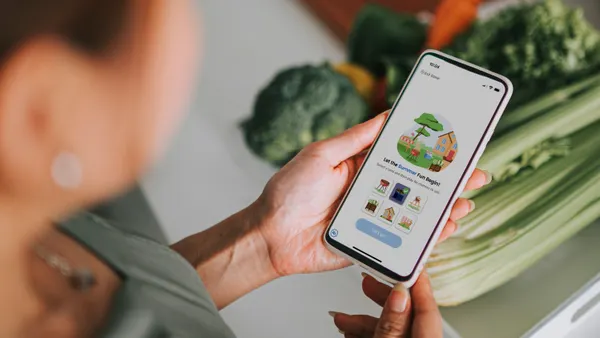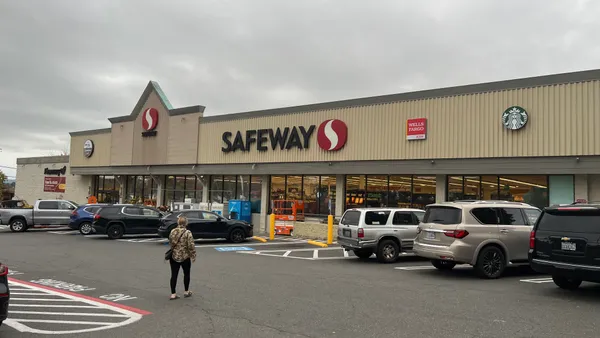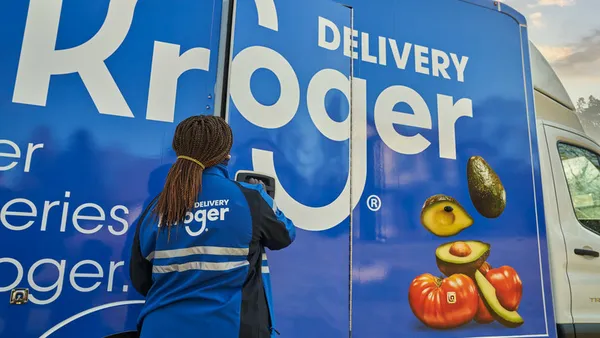In an ideal scenario, grocers would have full control over their delivery, offering in-house, branded service with their own workers picking, packing and bringing orders to customers.
But the steep cost of owning delivery end-to-end mean grocers oftentimes can’t have it all. Paying for the costly last mile has always been a particular challenge, and the growing demand for services like 30-minute delivery only makes that more difficult.
Still, the pandemic has raised online shopping to new heights and emboldened grocers to launch or strengthen existing branded delivery — service where retailers control the experience and promote it with their logo — as they seek to own more customer relationships and data. Kroger is gradually rolling out its own delivery service nationwide, while regional grocers like Cub Foods, SpartanNash and Giant Food are investing in branded services that often exist alongside partnerships with app marketplace giants like Instacart and DoorDash.
Retailers generally believe customers have higher satisfaction with branded delivery, particularly with white-glove — premium — service, said Daryl Porter, senior partner of omni operations at Tomorrow Retail Consulting. Oftentimes, they're offering generous promotions to get shoppers to use them.
Branded deliveries can be extremely valuable for customers' first orders and bringing them back to the retailer again and again. "We know that if a customer can get to four orders, they can be extremely sticky with the retailer,” Porter said.
SpartanNash, which has its Fast Lane service across more than 70 Midwest stores and Groceries to Go at its Martin’s banner in southern Michigan and northern Indiana, has seen that customers who place three orders are more than 75% likely to place another order with them, which then bumps to more than 80% after their fourth order, said Matt Van Gilder, SpartanNash's director of digital marketing and commerce.
Grocers that have customer density in specific areas can utilize route optimization and order batching to drive delivery costs down, said Porter. Kroger, for example, credits route optimization as a factor for why its variable fees can be as low as $6.95 for its expanding Kroger Delivers service. For grocers strapped for resources, numerous vendors, like Point Pickup and delivery management software solution eLogii, aim to help them tap into those efficiencies.
As grocers face a wider competitive landscape online to win shoppers' dollars, branded delivery can potentially unlock deeper shopper loyalty. But in the face of labor challenges and costs, grocers are trying to figure out how to optimize their own delivery services while minimizing downsides.
Discovering how to co-exist
Sources said they expect grocers to run branded delivery services alongside popular app platforms while playing up key points of differentiation.
Giant Food, for example, aims to serve a variety of customer desires, from in-store shopping options to online, and sees Instacart, its partner since 2016, as another way to connect with shoppers, said Gregg Dorazio, who heads up e-commerce for the grocer.
With its own offering, Giant Delivers, which launched in 2019 as a refreshed version of its online grocery delivery platform formerly known as Peapod by Giant, the Ahold Delhaize banner is looking to offer customers flexibility with speed and fees for delivery, while also giving them price value through its own e-commerce service, Dorazio said.
Grocers are showing they want to feed consumers' healthy appetite for faster delivery, but face the complexity of quickly delivering a high volume of orders.
Porter, who helped accelerate Walmart Canada's e-commerce strategy, expects on-demand, smaller basket orders of five to 10 items to heavily fall on crowd-sourced delivery models, while retailers will leverage branded delivery for stock-up trips and next-day delivery. Already, retailers are turning to providers like DoorDash and Instacart to manage faster service, particularly for orders in under an hour.
But several last-mile vendors are trying to solve the dilemma for retailers so they don't have to choose between speed or branded service. Store-hailing startup Robomart, which has just started rolling out on-demand mobile markets, is working on a branded, turn-key solution for retailers. So far, the fastest engagement from start to finish has been 1 minute and 51 seconds, while the average is under nine minutes, said co-founder and CEO Ali Ahmed. (Its website says it charges a "small hailing fee.")
Robomart's vision is to offer an online marketplace where customers can find and hail retailer-branded vans for specific categories, like grocery, ice cream and pharmacy, with Robomart taking care of restocking and fleet operations while retail partners will select the SKUs available, control their branding and set prices, Ahmed said.
Point Pickup, a retail-branded fulfillment and delivery provider that counts Kroger, Albertsons and Walmart among its clients, gives its workers the opportunity to shop the same stores and deliver in the same areas again and again, which helps them get faster at picking orders as they become more familiar with store layouts, said Tom Fiorita, the company's founder and CEO.
Meanwhile, taking the route of scheduled delivery has the potential to promote cost savings to customers as a differentiator, while driving bigger baskets for the retailer.
Determining what to own versus outsource
Figuring out which parts of branded service to fully control versus outsource has been a tricky area for grocers.
Giant Delivers gives the mid-Atlantic grocery chain more control over its e-commerce services and greater ownership of its relationship with customers by having its own employees handle picking, packing and delivering, said Dorazio.
The 30 seconds or so of face-time between drivers and customer is “critical" to learn customer preferences — like getting to know if they prefer delivery at the back or front door or if they don't want the driver to knock because the baby might be sleeping — and build a rapport over time, Dorazio said.
Other grocers that staff and train their own delivery drivers like to promote this fact to shoppers. As Walmart expands its in-home delivery, the retailer has highlighted the "highly-trained" associates with body-worn cameras it employs for the service — likely aimed at addressing some safety concerns over services that grant access to consumers' homes or garages.
Owning and managing the delivery fleet can be challenging for grocers of all sizes. Labor and fuel costs, vehicle maintenance and doorstep time — the time drivers spend at each customer's residence — all eat away at grocers' wallets, said Porter.
Giant Food has run into bandwidth challenges with its limited number of drivers and trucks, particularly on Fridays and weekends — popular times for people to want to get their groceries. The grocer has found that recently lowering fees for weekday service has helped address those capacity issues by encouraging shoppers to shift from those typically busy delivery windows to slower weekday ones. "Tuesdays have now become as popular as Sundays in terms of delivery windows," Dorazio said.
Other grocers, meanwhile, have found success with delivery vendors to handle the complex and costly last mile.
“Your typical grocer really is not equipped from a logistical standpoint, [an] employment standpoint to employ door-to-door delivery drivers. It’s not in their sweet spot,” said William Anthony, partner at law firm Blank Rome.
SpartanNash, which works with three different last-mile partners for its e-commerce services across its markets and uses its own drivers for a few select stores, has found that using third-party delivery vendors provides faster and more affordable service for customers, Van Gilder said.
Starting in 2018, SpartanNash began piloting with last-mile partners and has switched from relying mostly on its own workers to working with three vendors. The change was driven more by a desire to increase driver availability throughout the day for quick-turnaround service than by labor costs, Van Gilder said. SpartanNash employees pick and pack the orders, giving the company quality control. While the delivery drivers don't use branded vehicles, they do use branded paper bags, he said.
Minnesota grocer Cub is following a similar model of having its associates pick the orders and then using delivery drivers from a vendor. The drivers wear Cub-branded uniforms while making deliveries.
Being aware of the changing labor landscape
As the grocery industry grapples with hiring and retention challenges, grocers face the question of when they want to use their own workers for e-commerce operations versus when to outsource labor, especially for the delivery portion.
On the outsoucing side, the gig economy is booming, and flex work is a desirable option for drivers, according to Anthony and Porter. But there are legal and legislative challenges for grocers to be mindful of. Discerning between the classifications between employees and independent contractors can be tricky because criteria for the two often fall under numerous state laws, Anthony said. Some states are reconsidering how they classify independent contractors.
Grocers need to watch out for potential "joint employment" issues that could arise, like if they use a combination of delivery vendors and their own employees for the same duties, or if they control the method or means of how a contract worker performs their job, Anthony said.
“Independent contractors often point to ... a situation describing ‘Do you have employees doing the same thing that I do? Because if you do, then I can’t be an independent contractor,'" he said.
Anthony and Porter are hopeful companies can find a balance between employees and independent contractors.
“Giving more of those perks of full-time employment to the gig workers I think is where you see this going,” Porter said.
Regardless of the types of workers grocers rely on, they should let customers tip delivery drivers as a way to improve labor retention, sources said. Fiorita of Point Pickup noted tipping can give a “huge” bump, along with predictability, to workers’ pay, and customers who know their delivery driver tend to tip more, further incentivizing drivers to handle orders from the same customers.
As technology improves e-commerce orders, like with choosing substitutions or robotic order picking, there may become less need for a human connection with online fulfillment. Grocers with existing fleets can instead focus on drop-and-go service, Porter said. At some point, perhaps humans won't be needed at all in the driver's seat, with companies like Nuro, which is working with Kroger, and Robomart, which plans to shift to autonomous vehicles as regulations allow, focused on a still-nascent future with autonomous vehicles.
Drawing shoppers over to branded delivery
While sharing the same turf as — and oftentimes also partnering with — popular marketplace apps like Instacart and DoorDash, grocers face marketing challenges with branded delivery.
For Giant Food, finding the optimal strategy for communicating the value proposition of its in-house service is top of mind, Dorazio said.
“How do you get credit for moving customers through [our e-commerce site] and then into our pickup and delivery services when we know that is really a lot of the best value?” Dorazio said.
Along with recently updating its fees and minimums, Giant Food has also linked with CPG brands to offer delivery promotions to improve customer retention, Dorazio said. Like many grocers with branded delivery, Giant Food uses branded trucks, which Porter said have long been one way for grocers to draw attention to themselves, but are difficult to assess in terms of their marketing value.
The grocery chain isn't alone in trying to figure out how to incentivize customers to try their branded services.
Some, like Kroger and Ahold Delhaize, have recently launched subscriptions offering no-fee delivery, among other perks. SpartanNash is offering free delivery on all orders over $35 through its Fast Lane and Groceries to Go services during the month of February and last summer added half-off delivery fees to its e-commerce subscription program, which initially offered free pickup, Van Gilder said.
Free or lower fees are classic marketing moves that grocers are using for their delivery services.
"As we've started to get aggressive with our fee reductions and with our minimum reductions, I think that flexibility is moving more folks now over to engage with us when-they-want, how-they-want kind of model," Dorazio said.












